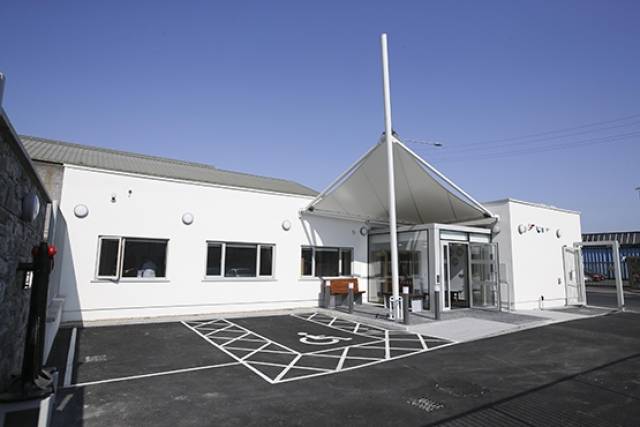Dublin Port Company has opened a new state-of-the-art Seafarers’ Centre at Dublin Port following a €500,000 investment in the facility. The new Seafarers’ Centre was unveiled today at an official opening attended by guest of honour, the Lord Mayor of Dublin Mayor Críona Ní Dhálaigh, who is also Honorary Admiral of Dublin Port.
The Seafarers’ Centre breathes new life into the site of the old Odlums flour mill. Housed in the former Odlums workers’ canteen, which had been in use up to the mill’s closure in 2012, the Centre now provides a base for vital services to sailors docking in the port, an essential workforce of the city’s economy. Features of the old canteen building such as decking, beams and the original exterior wall have been retained and preserved as part of the new design.
As Dublin Port’s first custom-built Seafarers’ Centre, it will support over 7,500 visiting seafarers a year arriving from all over the world, typically from countries such as India, China, Ukraine, Russia and the Philippines.
In addition to Dublin Port’s €500,000 investment, the International Transport Workers’ Federation has committed €55,000 in funding towards the completion of the Centre, helping to support its role in representing the best interests of transport workers globally.
Features of Dublin Port’s purpose-built Seafarers’ Centre include free Wi-Fi access for sailors to contact family and loved ones while ashore, cooking and dining facilities, and a relaxation and recreation space including a pool table, library and TV den with beanbags.
The new Centre also brings together two long-standing traditions in caring for seafarers in Dublin, the Anglican Mission to Seafarers (The Flying Angel) and the Catholic Apostleship of the Sea (Stella Maris). Both organisations will operate together under one roof at Dublin Port to provide spiritual guidance and friendship to seafarers of all faiths, and those of none. The Flying Angel will relocate to the Seafarers’ Centre from its existing location, while Stella Maris’ presence at the Centre will complement the organisation’s existing operation at its city centre location on Beresford Place.
Ardmhéara Críona Ní Dhálaigh said at the official opening; “I mo cháil oifigiúil mar Ardmhéara agus Aimiréil Oinigh Chalafort Bhaile Átha Cliath, tá an-áthas orm an t-Ionad Mairnéalaigh nua seo a oscailt.
I commend Dublin Port for creating such a welcoming facility for the thousands of seafarers who visit our shores and make a valuable contribution to our city and society. It’s wonderful to see the Catholic Apostleship of the Sea and the Anglican Mission to Seafarers working in tandem to continue their respective traditions of caring for seafarers, and providing these workers with a home from home.”
Chief Executive of Dublin Port Company Eamonn O’Reilly said; “We are delighted to open Dublin Port’s new purpose-built Seafarers’ Centre. It means that Dublin Port can provide sailors working thousands of miles from home with a space to rest, socialise and connect with family and friends under the care of Stella Maris and the Flying Angel. The Centre is a fine example of sustainable development in practice at Dublin Port. Odlums is an iconic part of Dublin Port’s industrial heritage, and that makes today’s opening particularly special.”
 Dublin Port Company has invested €500,000 in a new Seafarers’ Centre at Dublin Port. Housed in the former Odlums workers’ canteen, the Centre provides vital services to sailors docking at the port under the care of the Mission to Seafarers (The Flying Angel) and the Catholic Apostleship of the Sea (Stella Maris)
Credit: Conor McCabe
Dublin Port Company has invested €500,000 in a new Seafarers’ Centre at Dublin Port. Housed in the former Odlums workers’ canteen, the Centre provides vital services to sailors docking at the port under the care of the Mission to Seafarers (The Flying Angel) and the Catholic Apostleship of the Sea (Stella Maris)
Credit: Conor McCabe
We've got a favour to ask
More people are reading Afloat.ie than ever thanks to the power of the internet but we're in stormy seas because advertising revenues across the media are falling fast. Unlike many news sites, we haven’t put up a paywall because we want to keep our marine journalism open.
Afloat.ie is Ireland's only full–time marine journalism team and it takes time, money and hard work to produce our content.
So you can see why we need to ask for your help.
If everyone chipped in, we can enhance our coverage and our future would be more secure. You can help us through a small donation. Thank you.




























































